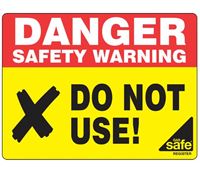 The company wants to ensure that it is doing all that is reasonably practicable to eliminate and/or reduce the risks from vibration when using such tools in the workplace. Here is some guidance for helping employees in your organisation use hand-held power tools.
The company wants to ensure that it is doing all that is reasonably practicable to eliminate and/or reduce the risks from vibration when using such tools in the workplace. Here is some guidance for helping employees in your organisation use hand-held power tools.
The first step should be to formulate a policy, with the purpose to prevent, so far as is reasonably practicable, the risk of hand–arm vibration syndrome (HAVS) arising from the use of hand-held vibrating tools and equipment. It should include the following.
A risk assessment should identify the various sources and characteristics of the vibration hazard, including the number of employees at risk, allowing for an overall risk evaluation. Those tools or processes of greatest risk should be prioritised and addressed first. It is important that the person carrying out any such assessment is competent to do so.
The basic measures for reducing occupational exposure to hand-transmitted vibration are to eliminate/reduce vibration by using alternative methods or equipment. Vibration transmission to the hands can be reduced by using tools fitted with “anti-vibration handles”.
Organisation at work, job rotation and suitably timed rest breaks may help to reduce vibration exposure. However, it should be remembered that the mathematical relationship between vibration magnitude and exposure time means that a large reduction in time is required before any significant effect on vibration magnitude is seen and it should, therefore, be considered low down the hierarchy of control.
It is important to provide information to employees on the risks associated with hand-transmitted vibration, as well as information on signs and symptoms of HAVS and why these should be reported to their employer, or, if applicable, to the occupational health staff as soon as they are identified.
Employees should be instructed on the actions required to minimise the risk and ways in which they can contribute to risk reduction and control, for example by maintaining good blood circulation, warming both hands and body prior to starting work in cold conditions, keeping warm while working, ensuring that tools are properly maintained, and reporting defects.
Further preventive measures include regular maintenance of vibrating tools and equipment. Information on how to correctly maintain items can be provided by manufacturers or suppliers. It is of equal importance to replace worn parts, correct unbalanced equipment and maintain anti-vibration mounts and devices.
Contact us should you require assistance.

If you want your business to run compliantly and efficiently, it’s important to pay attention to best practice in implementing health and safety policy.
The Health and Safety Executive (HSE) website contains useful information on the workplace laws that cover the processing, manufacturing and packaging of a wide range of goods, including:
These laws therefore cover a wide range of equipment and accessories.
Packaging and labelling
As well as the safety of the goods themselves, there are guidelines about how they are packaged and marked or labelled. These are to ensure the safety of workers who handle the goods and transport them, as well as the consumers who buy them. Appropriate safety and warning labels ensure workers are aware of dangerous goods and hazards, so goods can be handled, stored, transported and distributed according to best practice.
Packaging labels are used to make sure goods are handled according to the nature of their contents by indicating, for example, if they contain something that is fragile, hazardous or delicate. They are used by manufacturers to ensure the safety of their products during storage and distribution.
Safety labels
There is a huge range of safety labels available that are designed to meet all business labelling needs. For example, most workplaces use access labels to indicate entrances and exits, accessible areas, prohibited areas and convey other access-related instructions. Fire safety labels are used to guide employees and visitors in the event of a fire, while first aid labels are used to address the treatment of injuries.
Among general safety labels are those that warn of potential hazards, such as very hot water in a washroom or hot surfaces in a kitchen. Responsible employers should clearly label where water suitable for drinking can be found and apply warning labels to outlets where the water is not suitable for drinking.
There are also specific types of safety stickers and hazard labels available for:
Legal requirements
In addition to general legislation, special requirements apply to several business sectors. These include retailers, as well as those who manufacture, process or distribute the following:
Taking the time to ensure your business is complying with workplace law is very important. If you have any doubts or questions, it’s always best to check with your local trading standards office, as this is a good way to make sure you are trading legally. You can also use your local office to report anyone trading illegally.
Finally, while complying with the law is essential, best practice for using safety labels should also become part of your internal business processes, as it will help minimise the risk of accident or injury, ensuring your employees are working in a safe, healthy environment.
Contact us should you require assistance.

Health and safety requirements when working from home
If you have more than five employees, you have a legal requirement to assess potential risks to their work environment before employment begins and record any significant findings. You must:
Before an employee can begin working from home, you must perform a risk assessment. This will prevent and control potential risks to your employees, and make sure you are meeting all the health and safety requirements.
Although your employees might be working from the comfort of their home, as an employer you still have the same duty of care for them as you do for your office-based employees.
The risk assessment includes checking the workstation, space, lighting, flooring, ventilation, desk, chair, computer, data security, relevant insurance, electrical installation and anything else required for the employee to work safely and effectively.
The aim of the risk assessment is to highlight areas of concern in relation to health and safety while working from home, as well as to help you decide on the right level of supervision required for an employee’s welfare.
It is your responsibility to provide any equipment needed for the employee to effectively carry out their responsibilities. The employee is responsible for resolving any home-related issues highlighted in the assessment.
There are many factors that can influence your willingness to consider working from home as an option. The obvious question is whether the job can be done away from the office, if there is one.
Increased productivity: Homeworking could increase productivity by cutting out commuting time and allowing more flexible working.
Reduced overheads: There are a lot of costs associated with the running of an office. Utility Bills and the rental of the commercial space are just a couple of the things that you could save money on when an employee works from home. However, there might be some initial costs incurred in terms of additional equipment and training.
Geographical location: When hiring an employee to work from home, you can cast a wider net for candidates. It can also help organisations who want to expand into different geographical locations.
Reputation: Most potential employees now check out company reviews from previous employees before applying for a job or accepting an offer. Being a flexible employer can also contribute to attracting potential employees as well as retaining current employees.
Flexibility: A happy employee is a more productive employee. Although employees have to work the required hours agreed upon by all parties involved, they do have the option or deciding how they are going to spend that time to complete tasks and meet deadlines.
Good riddance to commuting: According to Inside magazine, the average employee spends nearly 200 hours commuting to and from work every year. Taking the worry out of commuting can result in higher productivity from an employee. Not to mention the costs they could save on not commuting, leading to happier workers.
Managing remote working: Managers might consider it more of a challenge to manage and monitor remote workers than they would managing office workers. Before considering remote working, you need to know that you can trust the employee to carry out tasks efficiently and with minimal supervision.
Security: You also need to worry about the security concerns involved with employees working from home, especially if your business handles personal and private information. As the new GDPR law came into effect earlier this year, employees should be trained in the importance of keeping company and client information safe. Businesses found to be in breach of the new GDPR laws are liable to a fine of up to 4% of annual profit.
Communication: Another concern is the possibility of poor communication or miscommunication between employees and even clients. However, with all the communication platforms now available to us (such as email, phone, Skype, Slack, etc) it has become much harder to excuse poor communication.
Limited group input: Homeworking means an employee will not be able to get as much input on projects from other employees in the office. However, the popularity of some of the platforms mentioned above does make communication between employees easier.
Distractions: A recurring concern for homeworkers is the number of distractions available to them. However, with online monitoring tools like Jira and Trello you can keep an eye on tasks as your employee completes them. This helps you stay on top of employee productivity.
Development: Working from home can cause difficulty in development and training for employees. Employees learn from their colleagues and co-workers. The office is a natural environment to impart knowledge, share information and upskill. However, with Skype and video conferencing keeping in touch is much easier than ever before. As of 2018, there is no reason why a remote worker should fall out of sync with the rest of your team.
If you require assistance, contact Walker Health and Safety Services Limited.
 Maintaining high levels of hygiene should be an essential element of how any workplace operates. As an employer, the Health and Safety at Work Act 1974 requires you to have a general duty to ensure the health, safety and welfare of all your employees, so far as is ‘reasonably practical.’
Maintaining high levels of hygiene should be an essential element of how any workplace operates. As an employer, the Health and Safety at Work Act 1974 requires you to have a general duty to ensure the health, safety and welfare of all your employees, so far as is ‘reasonably practical.’
The issue of hygiene is a part of this legislation, so you need to be sure you are providing the facilities and information for your employees to create a hygienic and clean workplace.
Why is workplace hygiene important?
There are potential dangers for any workplace if there is little or no emphasis on why hygiene is important. Primary among these risks is the possibility of infection, whether it’s through poor personal hygiene, slapdash office cleaning or badly managed washroom facilities. You can prevent many of these problems by having a strategy for maintaining a hygienic workplace.
Personal hygiene
This refers to the habits, cleanliness and appearance of your employees. It can be a sensitive area for employers and managers, so an official policy can diffuse any awkwardness by setting down exactly what is expected from everyone. Depending on your business, there may be options to provide shower facilities if employees exercise before work or rely on a bike for transport, and you can ask that hair washing and grooming facial hair is a part of usual personal hygiene for work. Hand washing and the use of hand sanitisers are also key tools to help prevent the spread of illness.
Washroom facilities
Your policy on hygiene requirements should ensure that washrooms equipped with running cold and hot water are provided for all employees. You should also provide hand soap, toilet paper and towels for drying hands. This allows employees to attend to their personal hygiene when they have finished using the facilities. If you contract the cleaning of toilets and washrooms to an outside agency, you should be clear about the levels of cleanliness you require and how often cleaning should be done.
Kitchen
Kitchens can be a health risk if proper cleanliness is not observed. Any area where food is prepared or hot drinks are made should have a high level of cleaning, including preparation surfaces, utensils and cups, mugs, plates and cutlery, where provided. Your employees are entitled to complain if they consider there is a health risk through poor maintenance and cleaning of the kitchen area, but you can also encourage them to take responsibility to protect themselves and practice a good hygiene regime.
Office cleanliness
Employees should be encouraged to be responsible for cleaning and maintaining their own work areas or workstation. This can be part of your hygiene policy so everyone is aware of it and agrees with it. Surfaces can be cleaned with disinfectant to reduce the possibility of bacterial infection, and desks should be kept tidy and as clutter-free as possible. If employees have individual bins, it’s important to ensure these are emptied on a daily basis.
Good hygiene makes good sense
When your employees are aware of why it is important to have a hygienic workplace, they are more likely to follow your policy guidelines and create a pleasant and safe environment in which to do their jobs. If everyone is vigilant, sickness levels in the workplace can be significantly reduced.
Contact us should you require assistance.
 Just like safety issues in the home, such as maintaining electrical appliances and protecting children from hazardous materials, a workplace needs adequate maintenance and protection to keep employees safe. Sensitive problems such as bullying can be addressed by training and the implementation of proactive management policies, but other common health and safety hazards that can have a serious physical impact need to be addressed by supplying the correct safety equipment. Here is a quick guide to what employers should be aware of to ensure workplace safety. Continue reading
Just like safety issues in the home, such as maintaining electrical appliances and protecting children from hazardous materials, a workplace needs adequate maintenance and protection to keep employees safe. Sensitive problems such as bullying can be addressed by training and the implementation of proactive management policies, but other common health and safety hazards that can have a serious physical impact need to be addressed by supplying the correct safety equipment. Here is a quick guide to what employers should be aware of to ensure workplace safety. Continue reading